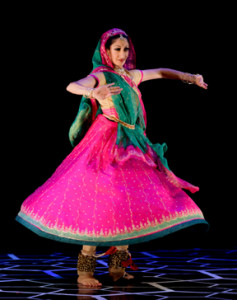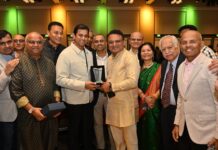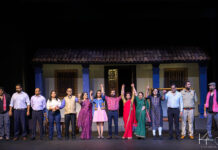 SAN JOSE, CA: There is much to be said about historical fiction, historical storytelling and reenactments.
SAN JOSE, CA: There is much to be said about historical fiction, historical storytelling and reenactments.
Yet, whatever the intended audience may have read or heard of the novel, “The Twentieth Wife” by Indu Sunderesan , they were treated to an original, powerful, and entertaining music and dance adaptation.
Farah Yasmin Shaikh and her team provided a sensory extravaganza with flawless choreography, soulful music, melodious singing, powerful narration, and the elegance of Kathak binding it all together seamlessly in one mesmerizing act.
The first joint production of EnActe Arts and Sangam Arts, two Bay Area organizations founded by Vinita Sud Belani and Usha Srinivasan respectively, was presented in honor of National Women’s month of March. Together, these entities created a synergy that united various performing art pieces to present a coherent whole that was somehow larger than the sum of its components. In recognition of their tireless efforts to connect arts to the people, they were given commendations by Councilman Ash Kalra on behalf of the mayor, Sam Liccardo and Councilwoman Carusco of the city of San Jose.
Kathak is an ancient dance form of India with roots in devotional story-telling but was adapted to include performances before Moghul court mehfils with emphasis on abhinaya (facial expressions) and rhythmic foot movements and fluid hand formations to depict mood. It is only fitting then that this was the medium chosen to present the story of Mehrunnisa (Sun of Women) who became the twentieth wife of Salim, son of Akbar, who is known as King Jahangir in history.
This is as much a love story between two star crossed lovers, as it is a tale of the politics of power, of betrayal and treachery, and of the power behind the veil wielded in the zanana mahal (harem). Set in the 16th Century, when women were veiled behind closed doors, Mehrunnisa rose from obscurity to reign as a formidable influence when she married King Jahangir.
The evidence of her power is found in historical references, as someone who issued royal orders, appreciated art, designed Imperial buildings and gardens, opened orphanages, traded successfully on both sides of the globe, minted coins in her own name – in short, reached far beyond what could be dreamed by a mere woman in the late sixteenth century.
Farah breathes life into all the eleven characters, men and woman she portrays in the span of less than two hours, and arcing a chronology of almost thirty five years as she twirls and turns through Mehrunnisa’s life.
Farah’s grace and expressive beauty tells the story of Ghias Beg, Mehrunnisa’s anguished and helpless father as a soldier fleeing Persia to the courts of Akbar in India. She then dashes around the stage as the young, nubile, winsome, energetic, curious eight year old Mehrunnisa eagerly watching preparations for Prince Salim’s first wedding, and attracts the attentions of Padshah Begum Rukaiyat, Akbar’s trusted wife.
As the story unfolds, Radhika Rao’s powerful voice deftly delivers excerpted pieces from the original story, and we learn that Beg rises through the ranks and Mehrunnisa becomes quite knowledgeable about the ways of the harem, while the Mughal Empire expands in influence through multiple political wedding alliances. Farah’s Akbar is a strong gaited, just, and balanced King, while Salim is portrayed at this time as a young, restless power hungry lad plotting his father’s death, and straining that relationship through a failed assassination attempt.
Enter the Iron Princess, Jagat Gosni, Salim’s Hindu wife, where Farah changes into a red lehenga to reflect the traditional Hindu accoutrements in vogue, and her facial expressions and gait mirror Gosni’s haughty mannerisms. Farah portrays the love triangle between the Salim, smitten by the enigmatic Mehrunnisa, Jagat Gosni’s chagrin and helplessness, and Mehrunnissa’s coy yet innocent flirtations.
Farah’s artistic flair showcases the vibrancy during the Meena Bazaar scene where she depicts the women of the harem shopping and cavorting without their veils or purdah.
Radhika continues the story by narrating that in another chance encounter with Mehrunnissa, Prince Salim learns of her impending marriage and vows to get it dissolved so he could claim her for himself.
A piece of exquisite dancing follows, emoting Mehrunnisa’s rapture at being desired by the prince, no matter how fruitless the outcome. At Akbar’s death bed, Farah’s fast footwork and intricate spins reveal the vulnerabilities of love and affection felt by father and son who desire tranquility as Akbar draws his last breath, leaving Salim as the new Emperor.
Meanwhile, Farah’s ferocious battle scene narrates the demise of Mehrunnisa’s uncouth and philandering soldier husband, Ali Quli, at the hands of the royal army because of his treachery, as well as the horrified reaction on her through complex footwork, energetic movements across the stage, smoldering eyes and hand gestures.
Mehrunnisa and her daughter Ladli are delivered back to Kandahar to Salim’s court by a quirk of fate, ultimately leading to their reunion engineered by Begum Rukaiyat. Farah unleashes the full power of the royal dance in these moments of rapture, exhibiting technical rigor and regal persona.
In the finale, Salim, now known as King Jahangir, marries his love, and names her Noor Jahan (Light of the World). He disengages with war, choosing to spend his time expanding culture and goodwill, while Noor Jahan claims her place in history as the most powerful woman of the Moghul empire – as a true power behind the veil.
Overall, many magical moments on stage were punctuated with regular applause from the appreciative audience. In places where long time periods are depicted, moving figures and visuals projected on the backdrop, with translated verses being narrated in unison by Radhika, bridges the transition smoothly .
The original score by Salar Nader added a multi-layered musicality to the show. A virtuoso violin performance by Raginder Momi Singh, Sarod ably played by Ben Kunin, and superb vocals by Dipti Warrier evoke a complete palette of emotions.
The bols from the tabla, played by Salar Nader, set the beat in perfect synchronicity with Farah’s rhythmic footwork and joyfully-executed chakras (turns) for dramatic flair during each tukra (piece). The show’s superb direction by Mathew Spangler is evident in how the various elements of music and dance were woven in with simple set designs, stylistic visuals, and powerful story-telling to depict the life and times of Noor Jahan!
Archana Asthana
India Post News Service







